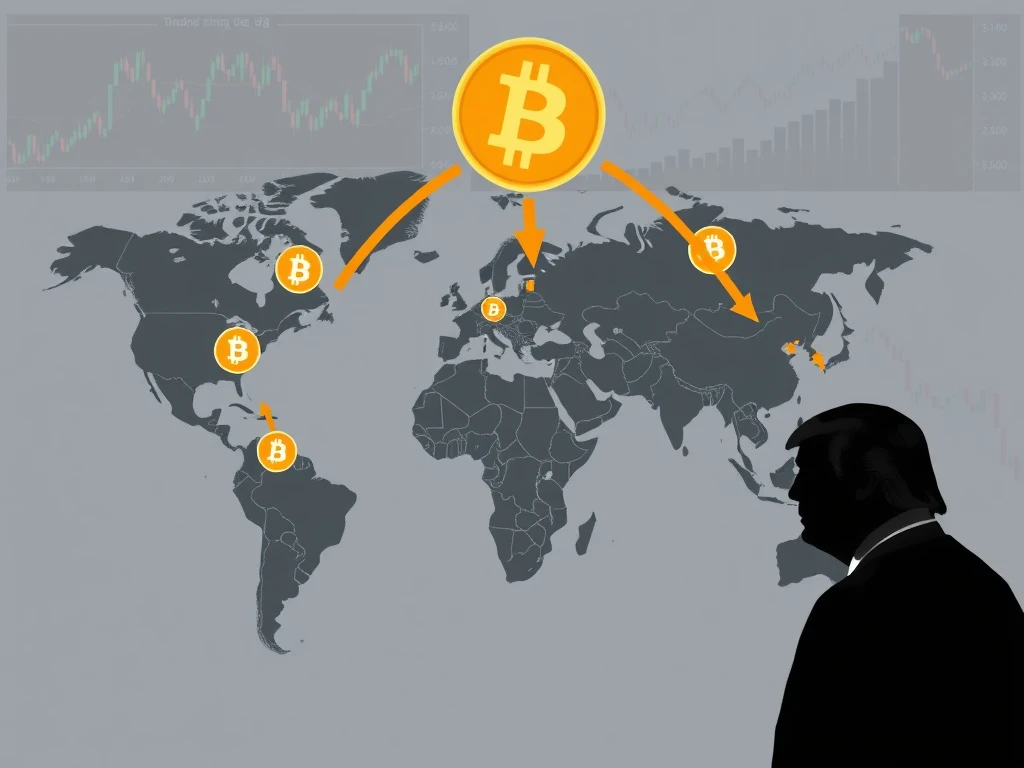Shocking Trump Tariffs: Global Bitcoin Miner Prices to Plunge Outside US

The cryptocurrency world is once again reacting to policy shifts, this time from the Trump administration. New tariffs imposed by the former president could drastically alter the landscape of Bitcoin mining, particularly for operations outside the United States. Imagine a scenario where the cost of essential mining rigs suddenly drops, but only if you’re not in the US. This isn’t a hypothetical – it’s a potential reality outlined by Hashlabs Mining CEO Jaran Mellerud. Let’s dive into how Trump tariffs could trigger a surprising price shift in the Bitcoin miner prices and what it means for the global Bitcoin mining industry.
How Trump Tariffs Could Slash Bitcoin Miner Prices Globally
The core of this potential price shift lies in the concept of “reciprocal tariffs” introduced by the Trump administration. These tariffs, impacting nearly every country, could inadvertently create a boon for non-US Bitcoin mining operations. Here’s the breakdown of how this surprising economic ripple effect is expected to unfold:
- Reduced US Demand: Tariffs increase the cost of importing mining rigs into the US. This price hike is predicted to significantly decrease demand within the United States.
- Surplus Inventory: Manufacturers, who initially geared up to supply the substantial US market, will now face a surplus of mining rigs.
- Global Price Drop: To offload this excess stock, manufacturers are likely to lower prices for buyers outside the US, making Bitcoin miner prices more competitive in other regions.
Mellerud emphasizes, “As machine prices rise in the U.S., they could paradoxically decrease in the rest of the world.” This creates a unique situation where US mining operations might face increased equipment costs, while their international counterparts could benefit from cheaper hardware, potentially leveling the playing field in the global Bitcoin mining arena.
The Stark Reality of Increased US Bitcoin Miner Prices
To illustrate the immediate impact of these Trump tariffs, consider a standard mining rig priced at $1,000. Before tariffs, this was the baseline cost. Now, with tariffs in place, the same machine could cost a US-based miner $1,240 – a substantial 24% increase.
Mellerud points out the stark contrast: “Meanwhile, in Finland and most other countries, there are no tariffs, so the cost of a $1,000 machine remains unchanged.” This price disparity creates a significant disadvantage for US mining operations. In an industry where margins are often tight, such a price increase can be the difference between profitability and unsustainability.
Key Takeaway: Trump tariffs are set to directly inflate Bitcoin miner prices for US-based operations, making it more expensive to acquire and upgrade equipment.
Non-US Bitcoin Mining: Poised to Capitalize on Lower Mining Rig Prices?
While US mining faces potential headwinds, the scenario looks brighter for Bitcoin mining operations in other parts of the world. The anticipated drop in mining rig prices outside the US could be a catalyst for growth and expansion. Here’s how non-US miners might benefit:
- Expansion Opportunities: Lower equipment costs make it more financially viable for existing non-US miners to scale up their operations.
- New Entrants: Reduced barriers to entry could attract new players to the Bitcoin mining space in regions benefiting from lower mining rig prices.
- Increased Hashrate Share: As non-US operations expand and US growth potentially stagnates due to higher Bitcoin miner prices, the global distribution of Bitcoin’s hashrate could shift. Non-US regions could capture a larger share.
Mellerud suggests this price shift could lead to a redistribution of Bitcoin’s hashrate, stating that falling mining rig prices could enable non-US operations to “scale up and take a larger slice of Bitcoin’s total hashrate.” This doesn’t necessarily mean a collapse of US mining, but rather a potential recalibration of global mining power.
Uncertainty and Shaken Confidence in US Bitcoin Mining
Beyond the immediate price impact, Mellerud highlights a crucial long-term consequence: damaged confidence among US mining operators. Even if the Trump tariffs are eventually reversed, the uncertainty they create can be detrimental.
“Even if these tariffs are rolled back within a few months, the damage is done — confidence in long-term planning has been shaken,” Mellerud argues. The volatile nature of policy shifts under the Trump administration makes long-term investment in US mining a riskier proposition. Operators might be hesitant to commit to major expansions when critical factors like equipment costs can change dramatically and unpredictably.
This sentiment is particularly poignant given the initial optimism US mining operators felt with Trump’s return. The expectation of a more stable regulatory environment has been replaced by the reality of “unpredictable policy shifts.” While US mining still accounts for a significant portion of the Bitcoin hashrate, this uncertainty could hinder future growth and innovation within the sector.
Bitcoin’s Price Reaction and the Broader Market Impact
The news of Trump tariffs and their potential impact on Bitcoin mining comes amidst market fluctuations. Bitcoin itself experienced a dip, falling 4% in a 24-hour period to around $76,470, according to CoinGecko data. This price movement reflects the broader market sensitivity to macroeconomic factors and policy changes.
While it’s difficult to isolate the precise impact of tariffs on Bitcoin’s price, it’s clear that these policy shifts contribute to market volatility. The cryptocurrency market, still relatively young and reactive, often responds swiftly to news that could impact mining economics, regulatory landscapes, and overall investor sentiment.
Looking Ahead: Navigating the New Landscape of Bitcoin Mining
Trump tariffs have undeniably introduced a new layer of complexity to the Bitcoin mining industry. While US mining operations face potential cost increases and uncertainty, non-US miners could find themselves in a more advantageous position with potentially lower Bitcoin miner prices.
The long-term effects of these tariffs remain to be seen. Will US mining resilience overcome these challenges? Will non-US regions seize the opportunity to expand their share of the hashrate? One thing is certain: the global Bitcoin mining landscape is dynamic and constantly evolving, and these Trump tariffs are the latest catalyst for change. Miners, investors, and industry observers will be closely watching how these developments unfold and reshape the future of Bitcoin mining.









